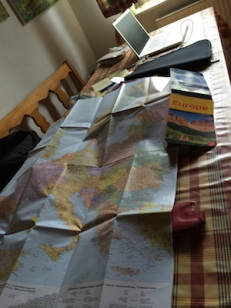
Festival of Saint Patrick
Saint Patrick’s Day is a popular religious festival held on the 17th of March, marking the death of Saint Patrick who was the patron saint of Ireland. Whilst it is an official Christian feast day, it is also a public holiday – a majority of people in both Ireland and Northern Ireland would celebrate Saint Patrick’s Day in some form regardless of whether or not they are religious. It is celebrated as a public holiday in Ireland, Northern Ireland, some Canadian provinces, and some British overseas territories. Anywhere that there is an Irish diaspora, there is a fair chance of Saint Patrick’s Day being celebrated. Despite being from Northern Ireland myself, a majority of people I know would celebrate Saint Patrick’s Day by going out drinking with their friends. This was an activity that was encouraged even hundreds of years ago.

The story of Saint Patrick follows a man who was born in Roman Britain who was taken to Ireland as a slave. After he escaped, he returned to convert the Irish to Christianity. There are many legends around him, following him driving the snakes out of Ireland – although some people see this as an allegory for driving out traditional beliefs such as paganism. Whilst the idea that he physically drove out paganism is inaccurate, he did facilitate the rise of Christianity in Ireland through the establishment of churches and schools. However, the continued celebration of Saint Patrick’s day in Ireland and in Northern Ireland has very little to do with the original tale of Saint Patrick – at least in my experience.
It is often commented on that a majority of people who have ancestral roots in Ireland but were not born in Ireland themselves celebrate Saint Patrick’s Day more than those in Ireland. Irish people who moved, particularly to the United States, transformed Saint Patrick’s Day into the holiday that it has currently become. Cities like Boston, which is famous for the large number of people with Irish ancestry, New York City, and Chicago are widely known for their extensive celebrations. For example, Chicago coloured its river with green dye to mark the holiday – despite blue being the national colour for Ireland. Whilst the overuse of green was eventually adopted by Irish people during Saint Patrick’s celebrations, it was mostly due to tourism.

Whilst in my country, the celebration of Saint Patrick’s Day was affected by sectarianism as it was seen as being a “Nationalist” holiday. Some of the population, Protestant Unionists, saw themselves as being British and Catholic Nationalists saw themselves as Irish. Whilst it was a public holiday, the unionist government of Northern Ireland did not observe Saint Patrick’s Day for a long time. During the Troubles, public Saint Patrick’s Day celebrations were rare and were associated with the Catholic community. Since the end of the Troubles with the Good Friday Agreement (1998), there have been cross-community parades in Northern Ireland which attract many spectators.

Nowadays, Saint Patrick’s Day is both a day of celebration and also a day to promote Irish culture across the world. The most prominent visits are that of the Irish Taoiseach with the President of the United States. Since the late 90s, there has been a more inclusive notion of “Irishness” rather than on ethnicity, tradition, or religious background.
All I ask of the reader is that they do not say “St Patty’s”, it is “St Paddy’s”.

Eva from New England
Why do people travel?
You May Also Like

A Wonderful Diversion
29 October 2021
Bree and Peter from Brisbane, Australia
11 April 2014